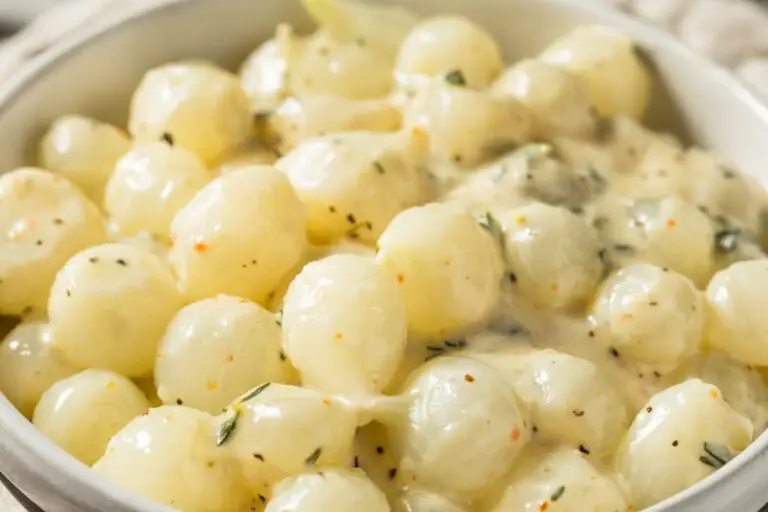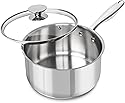Tender pearl onions swimming in a silky cream sauce made with evaporated milk - this vintage creamed pearl onions recipe from the 1930s delivers restaurant-quality results without the fuss of modern techniques. Evaporated milk creates a luxuriously thick sauce that holds up beautifully, making it perfect for make-ahead holiday entertaining. The secret lies in carefully selecting the pearl onions and knowing exactly when to stop cooking them for that melt-in-your-mouth texture.
Back in the 1930s Kitchen
The Great Depression taught American home cooks how to stretch their ingredients and create maximum flavor with minimal fuss. Evaporated milk, a product that came to market in the late 1800s, became a pantry staple by the 1930s; shelf-stable, affordable, and incredibly versatile. Home cooks loved it because it could perform the job of heavy cream without the expense, and it created silkier sauces than thinned milk ever could.
Creamed onions became the go-to Easter dish, the unshakeable Thanksgiving side, the quiet champion of church potlucks. Pearl onions, when you could find them fresh, were treated like little pearls themselves; carefully cooked just until tender, never mushy. This wasn't fancy food; it was smart food that somehow tasted better than anything complicated ever could.
What Makes This Creamed Pearl Onions Recipe So Good

Creamed Pearl Onions With Evaporated Milk Recipe
A 1930s classic that proves the best dishes often come from a place of careful resourcefulness and pantry wisdom.
- Total Time: 30 minutes
- Yield: 5 servings 1x
Ingredients
- 3 cups small white pearl onions
- 1 1/2 tablespoons butter
- 2 tablespoons flour
- 1/2 teaspoon salt
- Pepper to taste
- 1 cup boiling water
- 1 cup evaporated milk
Instructions
- Step 1: Prepare the Onions
Remove the outer dry skin from pearl onions carefully. In a 2-quart pot, bring 2 quarts of salted water to a rolling boil. Add peeled onions and cook in the open kettle until just tender (8-12 minutes), but still retaining their shape completely. Drain thoroughly, reserving 1 cup of the cooking water. - Step 2: Make the Roux
In a saucepan, melt butter over medium heat. Once melted and foaming, whisk in flour to create a smooth paste. Cook for exactly one minute while stirring constantly, until the mixture smells nutty and looks pale gold. - Step 3: Create the Sauce
Whisk in the reserved cooking water gradually, stirring constantly to prevent lumps. Once fully incorporated, slowly add the evaporated milk while continuing to whisk. Cook over medium heat, stirring frequently, until the sauce thickens enough to coat the back of a spoon (about 5 minutes). - Step 4: Season and Combine
Taste the sauce and season with salt and pepper to your preference. Gently fold in the drained onions. Let everything warm through over low heat for 1-2 minutes, stirring gently. - Step 5: Serve
Turn the creamed onions into a hot serving dish. Serve immediately alongside ham, lamb, or as a standalone vegetable side dish.
- Prep Time: 15 minutes
- Cook Time: 15 minutes
- Category: Side Dishes, Vegetables
- Method: Stovetop
- Cuisine: American
Nutrition
- Serving Size: 3/4 cup
- Calories: 213
- Sugar: 3g
- Sodium: 280mg
- Fat: 43.7g
- Saturated Fat: 26.2g
- Carbohydrates: 9.1g
- Fiber: 0.1g
- Protein: 4.3g
- Cholesterol: 131mg
How to Make Perfect Vintage Creamed Pearl Onions
Recipe Variations, Serving Ideas, and Storage
Recipe Variations
Frequently Asked Questions
Yes, though the sauce won't be quite as silky. Use 1 cup of heavy cream mixed with ½ cup whole milk to mimic evaporated milk's consistency. The sauce may need slightly more cooking time to thicken, and it won't have quite the same subtle caramelized sweetness that evaporated milk brings.
Pearl onions are a specific variety bred to stay small and sweet—typically staying the size of a marble. Regular small onions (like small yellow onions) become stronger-tasting as they cook and won't achieve that melt-in-your-mouth texture that defines this dish. Pearl onions truly are the only choice here.
Blanch unpeeled onions in boiling water for 2-3 minutes, then plunge them immediately into ice water. The skins slip off easily once cooled. This method works far better than trying to peel raw onions and adds only 5 minutes to your total prep time.
Absolutely. Prepare the sauce up to 1 day ahead and store it in the refrigerator. Cook and drain the onions separately, then combine them gently just before serving. Reheat the sauce gently and fold in the onions at the last moment for the best texture.
Curdling happens when the sauce gets too hot too quickly or when cold evaporated milk hits a very hot roux. Always add liquid gradually while whisking constantly, and keep the heat at medium (not high). If separation happens, remove from heat and whisk in 1-2 tablespoons of cold milk or water to cool it down and re-emulsify.
No. Evaporated milk is unsweetened milk with 60% water removed—perfect for savory dishes. Condensed milk is evaporated milk with 40% sugar added, making it unsuitable for this recipe. Always check the label carefully.
Perfectly cooked pearl onions are tender throughout but still hold their shape completely. Cut one in half; it should be soft enough to cut easily but not falling apart. They should taste mild and slightly sweet, never harsh or still crunchy.
Frozen pearl onions work beautifully in this recipe and are often easier to find than fresh. Thaw them completely first, drain well, and reduce the boiling time to 4-5 minutes since they're partially cooked already. The results are virtually identical to fresh.
Baked or glazed ham, roasted lamb, and turkey are classic pairings. Creamed pearl onions also work wonderfully with roasted chicken, beef tenderloin, or even as a vegetable side for a lighter meal. Serve alongside mashed potatoes, egg noodles, or fresh bread.
While this violates the original spirit of the recipe, you can certainly add 3-4 slices of crumbled cooked bacon or 2 tablespoons of grated Parmesan to the finished sauce. However, try this classic version first—you might find you love it exactly as intended, with nothing competing for attention with the delicate onion flavor.
There's something quietly powerful about a dish that never goes out of style, never needs updating, and tastes exactly like it should every single time. This 1936 creamed pearl onion recipe carries all three of those qualities. What's the one dish on your table that feels like home? Is it something your grandmother made, or something you're creating for your own family right now? Please share your memory in the comments and if you make this vintage creamed pearl onions recipe, please leave a rating and review! Your feedback helps other home cooks find their own taste of the past.



0 comments